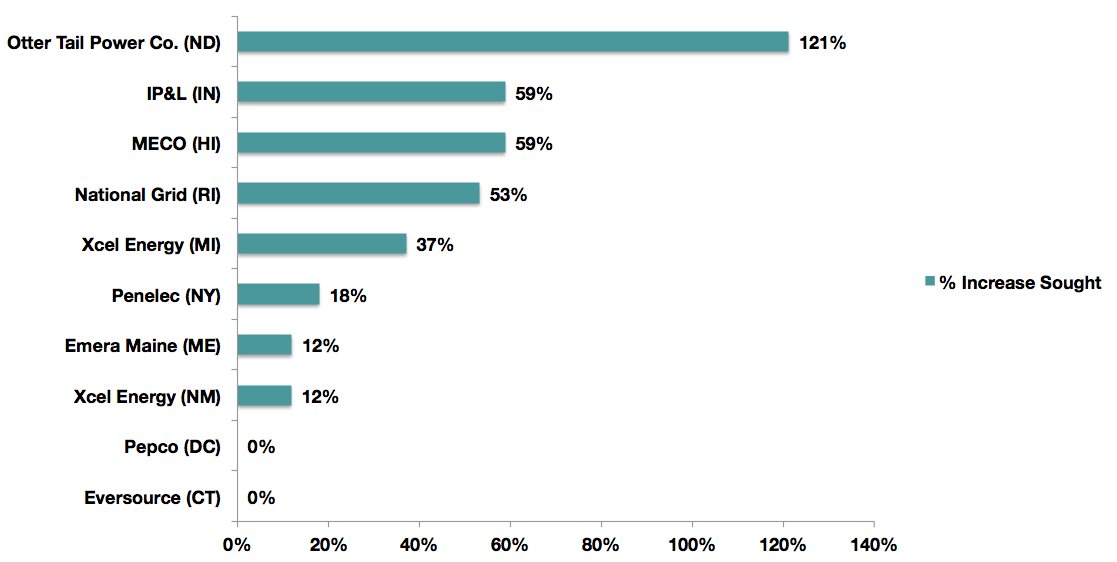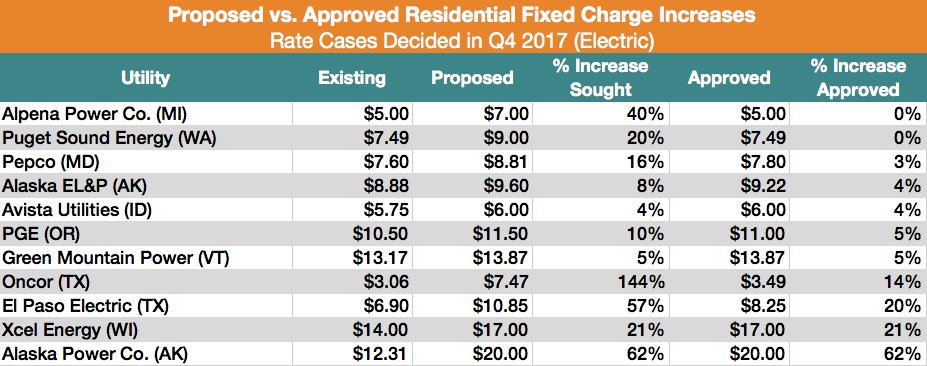President Trump’s decision on the Section 201 solar trade case dominated the energy policy news cycle over the past two weeks. The outcome of that case will certainly affect state markets, although some will be insulated by renewable energy procurement mandates that will continue to drive solar project development despite new tariffs and slightly higher prices. In other places, though, new tariffs will serve as a nail in the coffin for solar companies already struggling to adapt to separate state-level policy changes.
While the fallout from the trade case decision will be an ongoing issue in 2018, it’s hardly the only clean energy policy issue out there. That's why I caught up with Rusty Haynes, energy policy manager at EQ Research, for this week’s State Bulletin to see what he's tracking in 2018, in keeping with the theme of my previous two columns. For Haynes, it all about rate changes.
Fixed charge increases and how to resist them
This year, the major themes in utility ratemaking are fixed-fee hikes and mandatory demand charges. Sure, these topics aren't entirely new. But Haynes pointed out how utilities and regulators have put new twists on these concepts in recent proceedings.
According to EQ Research, a dozen utilities filed new rate cases in the fourth quarter of 2017. Ten of those cases address rate design, and among those, all but two utilities proposed raising their monthly fixed fee for residential customers. Four utilities proposed raising their residential fixed charge by 50 percent or more. One utility -- Otter Tail Power -- sought to boost its charge for North Dakota residential customers by a whopping 121 percent, from $8.00 to $17.70.
Proposed Residential Fixed-Charge Increases: Rate Cases Filed in Q4 2017

Source: EQ Research
Interestingly, while many utilities are looking to boost fixed charges, there’s a track record of high fixed fees being met with pushback.
In seven of the 11 rate cases decided in Q4 2017, state regulators did not allow fixed-fee increases for residential customers to exceed 5 percent. The other approved rate increases were relatively modest, with the exception of Alaska Power, which was permitted to raise its charge from $12.31 to $20.00 -- the full amount proposed.

Source: EQ Research
Haynes pointed out that there’s precedent for especially high fixed fees to be rolled back. In 2016, Connecticut regulators issued a final decision on United Illuminating’s rate case that reduced the utility’s $98 million revenue increase by $39 million, and actually lowered UI’s monthly service charge from $17.25 to $9.64. This decision was triggered by protests and petitions, and ultimately led to legislation that required the Public Utilities Regulatory Authority to establish a methodology to determine the maximum residential customer charge for standard service.
As a result of this blowback, Connecticut’s Eversource Energy is also expected to lower its fixed fee. In Eversource’s pending rate case, the fixed charge has been reduced from $19.25 to $11.88. The utility has also proposed to nearly double its volumetric rate in tandem, which could provide an incentive to customers looking to reduce their energy usage or purchase distributed energy resources.
Connecticut’s fixed-fee cut is an interesting example of public outcry producing results, according to Haynes. “If you don’t like what’s going on with nasty fixed charges -- get support from the legislature.”
“The problem for that is you’re potentially undermining the authority of state regulators to set rates,” he added.
Demand charges: "Some will be good, and some will be rotten"
Another development Haynes is watching is the introduction of demand charges for standard residential customers. Several municipal utilities have implemented residential demand charges in the past, in some cases targeted specifically at DER customers. But until recently, no investor-owned utilities had implemented mandatory demand charges for residential customers.
That changed last month when regulators approved Eversource Energy’s rate case in Massachusetts. The new rate structure includes a demand charge for new net metering customers, with the exception of low-income customers, beginning on December 31, 2018. Eversource is the first regulated utility to win approval for this type of rate. The utility successfully made the case that DER customers are causing an $8 million revenue loss, the burden of which was being shifted to non-DER customers.
Adding to the uniqueness of the case, regulators decided to eliminate Eversource’s optional residential time-of-use rate, while implementing a non-coincident demand rate, which does not align with peak demand on the distribution system. Regulators said the change was made to support “the rate structure goal of simplicity.”
Massachusetts has been one of the fastest-growing residential solar markets in the U.S. because electricity rates are high and residential customers receive full retail-rate net metering. Historically, home solar customers also received SREC payments on top of NEM. The state is now transitioning to its SMART program, with new tariffs announced just last month, which will simplify the incentive scheme and lower overall compensation, although Massachusetts is expected to remain a strong residential solar market overall.
The new demand charge in Eversource territory doesn’t take effect for nearly another year, but when it does, it will make solar somewhat less compelling -- although it's not clear how much, exactly. Eversource doesn’t have the most solar customers in the state; National Grid does. So the new demand charge may not hurt the overall solar numbers in Massachusetts. But Haynes pointed out the demand-charge debate in the state may not be over yet.
The Eversource demand charge "is a disappointing setback and unpleasantly surprising in a state that’s historically been very progressive on distributed solar and DERs,” he said. “Will the Dept. of Public Utilities of Massachusetts approve something similar for investor-owned utilities there when they come to the table with a rate case? My suspicion is yes, which is an even bigger problem than just Eversource.”
“Demand charges, however you put them in place, typically don’t end up favoring solar,” GTM Research solar analyst Austin Perea told me. “That will definitely hurt the payback period for NEM systems.”
One thing that could potentially mitigate the effect of the demand charge is that there is a slightly higher SMART incentive in Eversource territory than in other areas, which takes effect regardless of the shift to demand charges. Under the SMART program, “Eversource will have a higher all-in incentive rate that may help offset the rate change, but I don’t know to what extent at this point,” Perea said.
There is a chance the demand charge won’t take effect at all, though. Vote Solar has already announced plans to challenge the DPU’s decision in the Eversource case and could be successful.
As the debate in Massachusetts continues, Haynes noted that Pepco recently proposed creating a new demand charge of $1.447 per kilowatt-hour for all standard residential customers in Washington, D.C. -- not just solar owners. A universal residential demand charge has only been proposed a few times before in the U.S. (Arizona Public Service tried, but ultimately opted for a settlement with optional demand rates), but it could become much more common in the coming years.
“Many companies have been busy installing advanced metering infrastructure, and part of the motivation was to be able to play with or propose new rate structures,” said Haynes. “If you have smart meters, it opens the door to time-varying rates and demand charges.”
“I expect some will be good, and some will be rotten, for customers,” he added.
How utilities can remove barriers to EV adoption
Another trend Haynes said he’s watching for this year is how utilities and their regulators address ratemaking around electric-vehicle infrastructure.
In January, the California Public Utilities Commission approved the largest utility-sponsored EV charging program in the nation to date. The PG&E program includes 7,500 Level 2 chargers and a budget of $130 million. Southern California Edison and San Diego Gas & Electric both launched their own EV infrastructure pilots in 2016. SCE had four more transportation projects approved by the CPUC last month, including a transit bus electrification program.
This isn’t just a California phenomenon, however. Maryland could soon be home to the second-largest EV charging network in the U.S. if Baltimore Gas and Electric Company gets approval to build a portfolio of 24,000 chargers.
Haynes pointed out that Colorado and Minnesota have also launched proceedings (17I-0692E and 17-879, respectively) to investigate the need to accommodate a growing number of EVs.
In Colorado, a consortium of government agencies put out an EV market report last month describing goals and strategies for supporting EV infrastructure and accelerating the EV market.
The plan notes that Coloradans stand to reap billions of dollars in potential benefits from widespread adoption of EVs. In a high-adoption scenario, forecasts show:
- $4.1 billion will accrue to electric utility customers in the form of reduced electric bills
- $29.1 billion will accrue directly to Colorado drivers in the form of reduced annual vehicle operating costs
- $9.7 billion will accrue to society at large as the value of reduced greenhouse gas emissions

The plan, authored by the Colorado Energy Office, the Regional Air Quality Council, the Colorado Department of Public Health and Environment, and the Colorado Department of Transportation, notes that while Colorado is already a leading EV market, “barriers to adoption remain.” A lack of public charging, particularly EV fast‐charging along major transportation corridors, remains a major challenge.
The state government specifically calls for action from utilities and their regulators. “Utilities, with the support of the Public Utilities Commission or appropriate governance body, should investigate the wide range of actions they may take to support the emerging EV market,” the plan states. Colorado Public Utilities Commission has already started the conversation with experts how to support the proliferation of EVs and continues to work through its EV infrastructure docket.
The latest actions in Minnesota and Colorado “indicate those states are seriously thinking about moving the EV industry forward in a way that’s in the public interest rather than laughing off EVs and hoping they’ll go away,” Haynes said.